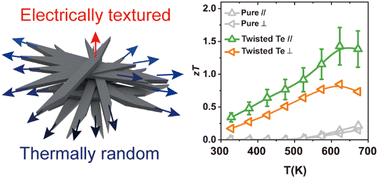Twisted grain boundary leads to high thermoelectric performance in tellurium crystals†
Abstract
Identifying an ideal microstructure for efficient thermoelectric materials has been complicated by the interplay between the electrical and thermal properties. The electrical properties of thermoelectric materials are often compromised to reduce lattice thermal conductivities and increase dimensionless thermoelectric figure-of-merit (zT). However, the increase in zT achieved using this strategy has recently stagnated. For example, elemental tellurium (Te) has exhibited a degraded zT of ∼1 for several years although it has gained considerable attention as a potential high-performance thermoelectric material. In this study, we demonstrate an unprecedentedly high zT of 1.42 at 623 K for 1% Fe2As-doped elemental Te crystals by utilizing the doping-induced twisting behavior of grain boundaries in Te. The unconventional twisted microstructure—twisted boundaries with aligned helical chains—enables an “electrically textured and thermally random” orientation. Therefore, the twisted Te crystal has a higher electrical conductivity and a comparable lattice thermal conductivity to the polycrystalline Te.



 Please wait while we load your content...
Please wait while we load your content...